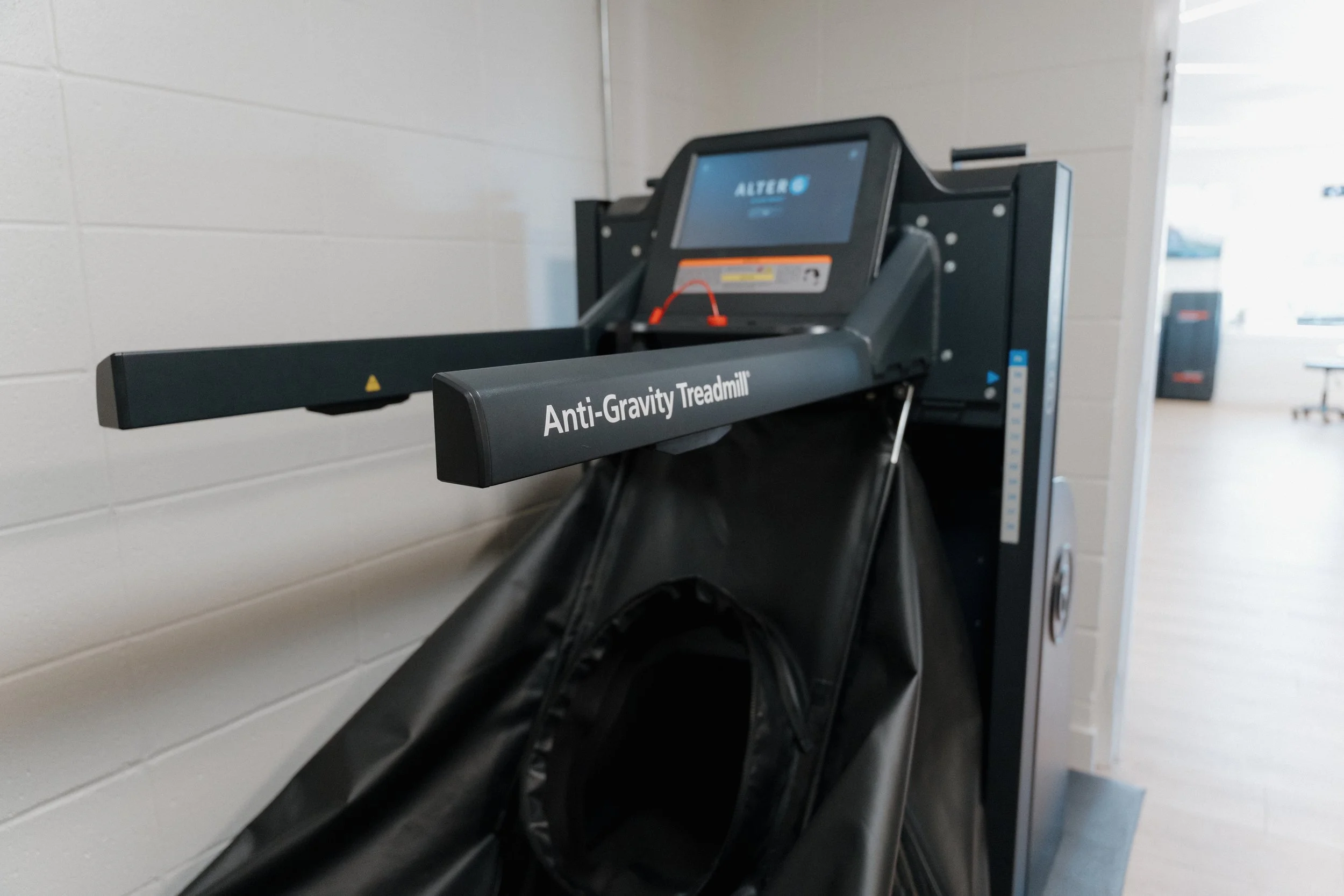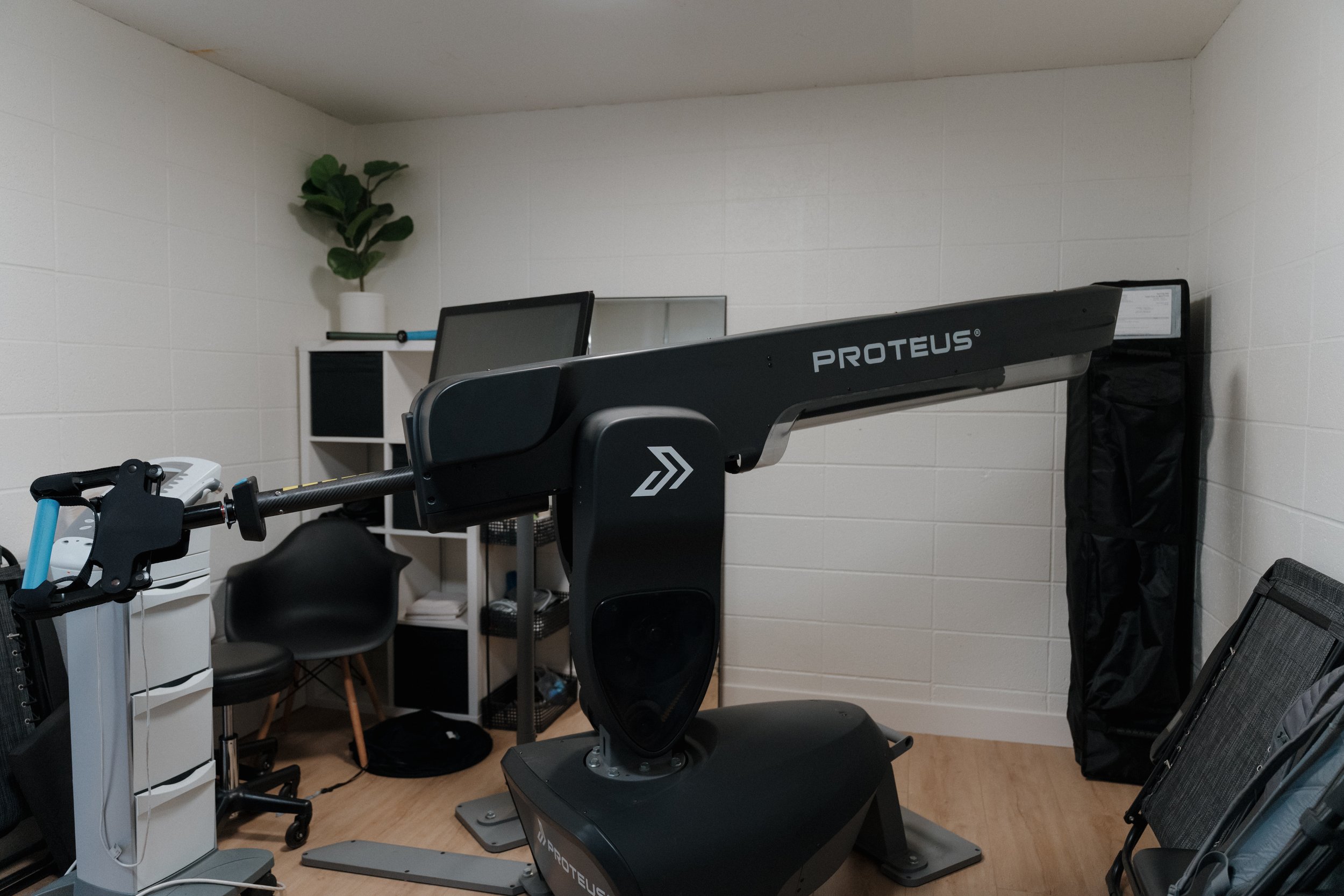Top 5 Physical Therapy Tools Every Athlete Should Know About
Why Is Recovery Important, and How Can These Tools Help Athletes Move, Train, and Perform at Their Best?
Recovery isn’t just about rest, it’s an essential part of training that allows athletes to rebuild stronger, prevent injuries, and sustain high performance over time. At Cuirim Sports Recovery, physical therapists use advanced recovery tools not just to speed up healing, but to restore movement efficiency, strength, and confidence in ways that go beyond traditional physical therapy methods.
At Cuirim Sports Recovery we use these five tools that every athlete in sports rehabilitation and recovery should know about.
What’s the Purpose of Each Recovery Tool?
Alter-G Anti-Gravity Treadmill
The Alter-G uses differential air pressure technology to reduce body weight while running or walking. This allows for progressive loading of the lower extremities without excessive joint stress. The Alter-G not only maintains cardiovascular fitness but also helps retrain neuromuscular control and stride mechanics in a controlled environment, allowing the athlete to focus on form, cadence, and foot strike patterns while gradually reintroducing load. The Alter-G is ideal for returning to running earlier in recovery phases while safely maintaining form and confidence. The Alter-G bridges the gap between early rehab and return to sport conditioning by allowing controlled exposure to running, sprinting, or plyometric movement long before full ground impact would be tolerated.
Proteus Motion System
The Proteus is a 3D resistance and motion-capture system that measures strength, power, and acceleration in real time. Unlike traditional weight machines, it challenges movement in multiple planes, simulating sport-specific movements. Cuirim Sports Recovery uses the Proteus to analyze rotational power, core stability, and multi-planar strength, where rotational forces are essential for sports like football, baseball, or MMA. The system provides instant, valuable feedback on efficiency, helping athletes identify and understand movement inefficiencies and how well they produce and control force throughout a movement. It is also valuable during late-stage rehab, when athletes transition from isolated strengthening to sport-specific movement retraining. This allows physical therapists to guide precise strength and performance programming. The Proteus quantifies movement quality, allowing our physical therapists to fine-tune training to restore power symmetry and optimize athletic mechanics, something which can be difficult to achieve through traditional resistance equipment alone.
Blood Flow Restriction (BFR) Training
Blood Flow Restriction Training (BFR) uses an inflatable cuff to partially limit venous return while maintaining arterial inflow. This creates a hypoxic environment in the working muscle, triggering metabolic and hormonal responses, including increased growth hormone and IGF-1, that stimulate muscle hypertrophy under light loads. BFR training allows athletes to train at a certain percentage of their one-rep max and still achieve strength and hypertrophy similar to heavy lifting. This is an evidence-based method for preserving and rebuilding strength during post-operative or injury recovery phases when high-load resistance training wouldn’t be appropriate. BFR training maximizes muscle activation safely and efficiently, enabling faster return of strength and function with minimal joint stress.
VALD Handheld Dynamometer
The VALD handheld dynamometer objectively measures muscle force output, symmetry, and progress. It quantifies isometric strength, offering far more precision than manual muscle testing. Cuirim Sports Recovery uses standardized setups to test strength in key groups such as quadriceps, hamstrings, hip abductors, rotator cuff, and grip. The data reveals not only the strength of a muscle but also how balanced the strength is between limbs and key groups. This helps clinicians identify weaknesses that increase risk for re-injury or poor performance. Beyond peak force, VALD can analyze rate of force development (RFD) and fatigue resistance, providing insight into how quickly and efficiently an athlete can generate force. Tracking this data over time ensures training programs are producing measurable progress. The VALD handheld dynamometer transforms subjective information into quantifiable, repeatable data, providing both the athlete and our physical therapist a clear picture of readiness for progression, return-to-play, and long-term performance tracking.
Normatec Compression Boots
The Normatec compression system uses sequential air compression to promote circulation and reduce muscle soreness. The boots inflate and deflate in a rhythmic pattern that mimics the body’s natural “muscle pump,” enhancing lymphatic drainage and accelerating the removal of metabolic waste such as lactic acid. Our physical therapists often use Normatec compression boots after high-intensity training, competition, or rehab sessions to reduce post-exercise inflammation and swelling. Athletes benefit from improved recovery times, decreased soreness, and enhanced readiness for the next training session. Normatec also supports injury prevention by maintaining tissue mobility and reducing residual muscle tension, especially for endurance or power athletes training at high volumes. While often seen as a luxury recovery tool, compression therapy is a clinically proven method to speed tissue recovery, enhance circulation, and support consistent performance throughout an athlete’s training cycle.
When Should You Use Each Tool?
Alter-G Treadmill
During early rehab or active recovery to reintroduce running mechanics at reduced loads. Ideal for return-to-running progression or conditioning with minimal joint stress.
Proteus Motion System
Before or during workouts to assess performance and movement quality, and later in rehab stages to restore rotational or multi-planar strength.
Blood Flow Restriction Training
During rehab or strength sessions, when traditional heavy lifting is limited, but often mid-session for isolated strengthening or endurance work
VALD Dynamometer
Before and after sessions to track progress, measure fatigue, and determine readiness for higher intensity or return-to-play benchmarks.
Normatec Compression Boots
After workouts, competitions, or long training blocks, to reduce soreness, improve circulation, and speed recovery
How Do Cuirim Sports Therapists Use Tools Differently Than Athletes Do?
Athletes may use these tools for general recovery, but physical therapists here at Cuirim Sports Recovery apply them strategically, guided by clinical reasoning and individualized parameters. Our physical therapists individualize protocols to meet the athlete’s recovery stage, tolerance, and goals. Tools like VALD and Proteus turn strength and movement into measurable data, allowing therapists to identify weaknesses or asymmetries early. Our physical therapists use these tools to systematically increase demand, moving from unloaded to full-load activities, or from controlled environments to sport-specific movements. Instead of isolating a single tool, our physical therapists combine technology with hands-on therapy, therapeutic exercise, and neuromuscular training to achieve complete individualized recovery. Recovery tools are most effective when used with purpose. Under the guidance of our physical therapists, these tools are not just for relief, but they become instruments of performance restoration and long-term resilience.
-
The frequency depends on the tool and training load. Devices like the Alter-G treadmill or Proteus can be integrated multiple times per week as part of a structured recovery or performance program. Compression therapy using the Normatec can be used daily, especially during heavy training blocks, while Blood Flow Restriction training and VALD assessments are typically performed under a physical therapist’s supervision 1-2 times a week. The key is balance, using recovery tools strategically, not excessively, to complement rather than replace proper rest and mobility work.
-
Some tools, like Normatec compression boots, can safely be used independently for general recovery. However, other tools such as BFR, VALD testing, and Proteus training require professional oversight for accurate setup and interpretation. Incorrect use of these tools can limit results or increase injury risk. Our physical therapists are trained to individualize parameters and ensure each tool supports your specific recovery or performance goal.
-
These tools are valuable for both. While originally designed for rehab, tools like the Alter-G and Proteus are now used proactively to enhance performance and reduce injury risk. VALD strength testing identifies asymmetries before they become problematic, and BFR can supplement low-volume or light training weeks to maintain muscle with minimal stress. In short, these tools don’t just help athletes recover, they help them perform smarter and stay durable throughout the season.
-
Not at all. While these technologies were originally developed for athletes, they benefit anyone looking to move better, recover faster, or return to activity safely. The same tools that help elite performers train at a high level also help everyday individuals recover from surgery, improve joint mechanics, or manage chronic pain. Whether you're an athlete, weekend warrior, or simply working toward a healthier lifestyle, our physical therapists can tailor these tools to meet your specific needs and goals.





